Vegetarian Butternut Squash Stuffing with Apple
Try this vegetarian butternut squash stuffing with apple, sourdough bread and sage for a delicious addition to your Thanksgiving meal.
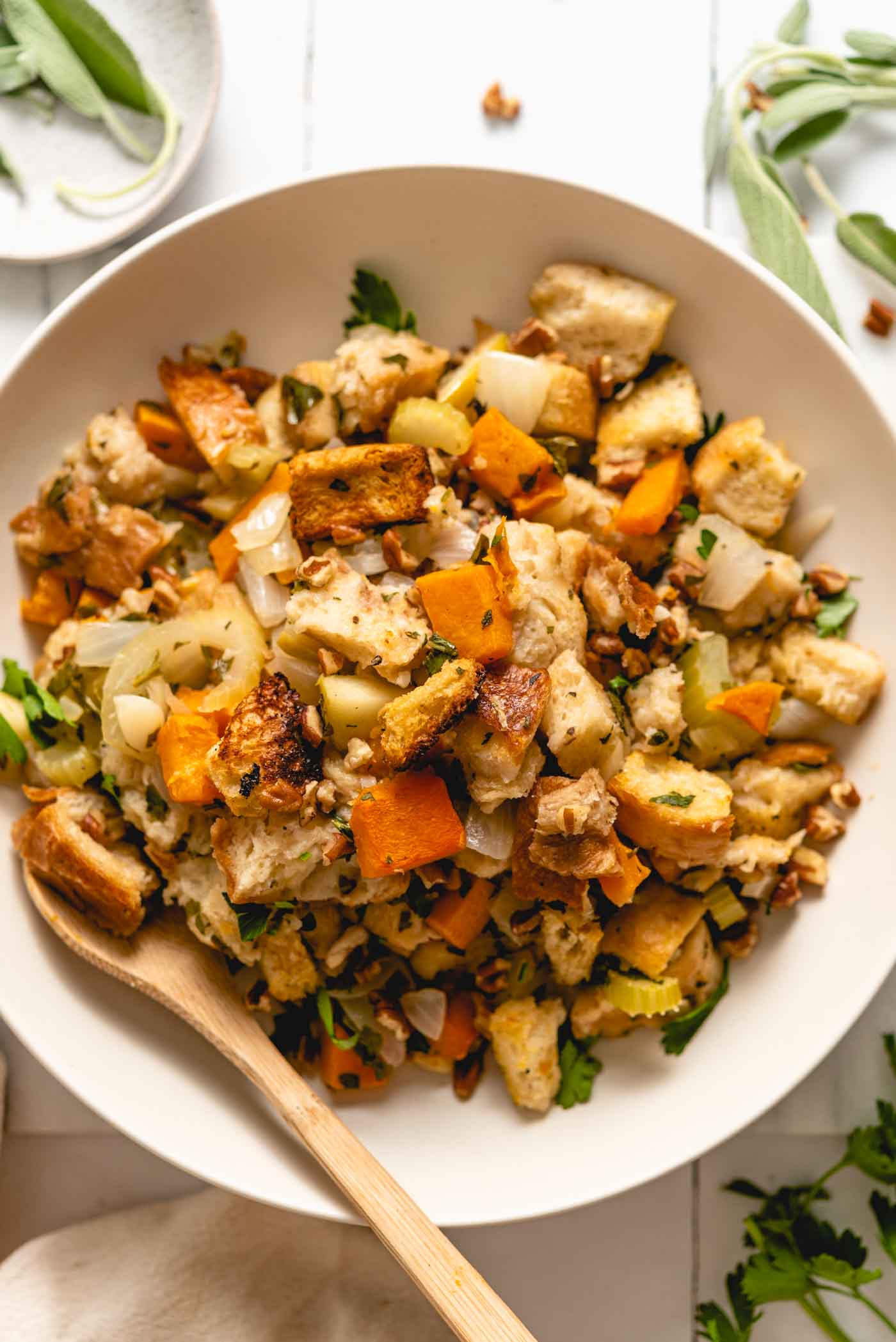
About the Recipe
If you’re looking to try something new for the holiday season, how about roasted butternut squash stuffing for a twist on a classic Thanksgiving side dish?
This recipe features traditional stuffing flavours like thyme, sage, herbs, apple, onion and celery with soft but crispy-on-top sourdough bread.
The roasted butternut squash adds a hint of sweetness that pairs well with the tart apple and fresh herbs.
Not only will this stuffing make your home smell amazing, it’s sure to be a favourite part of your Thanksgiving dinner or any other holiday meal.
Serve your homemade stuffing with mains like stuffed butternut squash or chickpea loaf.
For more holidays side dishes try healthy vegan mashed potatoes, green beans with onion and garlic, homemade vegan cranberry sauce, roasted golden beets, easy vegan mushroom gravy, wild rice salad and dijon roasted Brussels sprouts.
Ingredient Notes
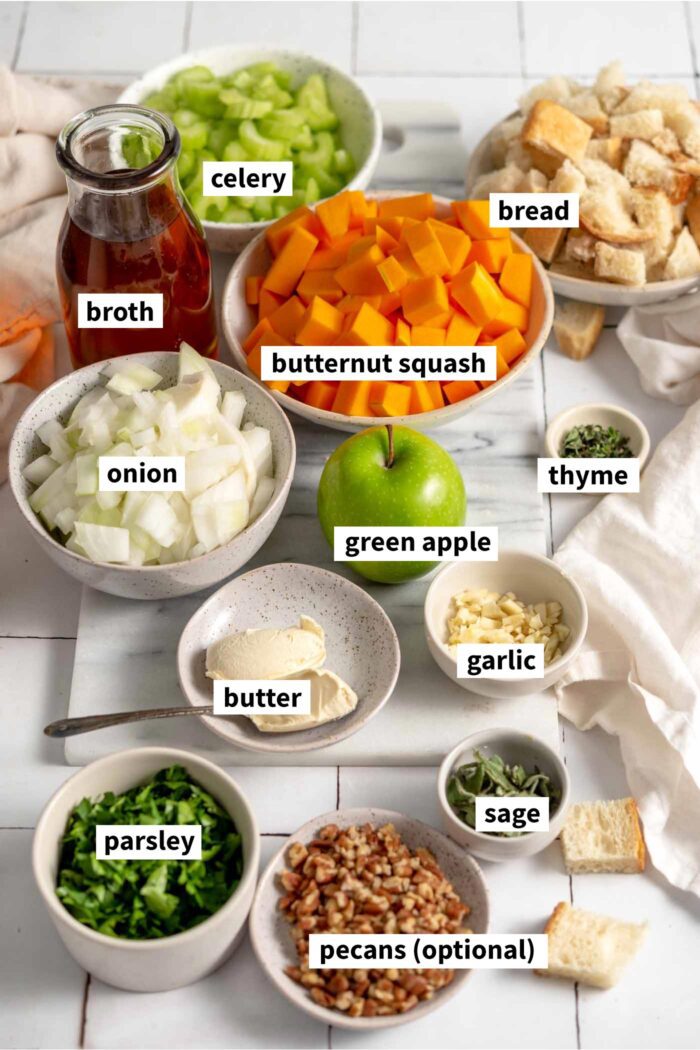
- Butternut Squash: You’ll need 1 small to medium-sized butternut squash or about 5-6 cups cubed. You can use frozen butternut squash cubes but I’d recommend using fresh. You can substitute another variety of squash or try sweet potato.
- Olive Oil: You can use olive oil or another other cooking oil for roasting the squash.
- Bread: I like sourdough bread for you can use any French bread, Italian bread, brioche or challah bread or any other kind of crusty or rustic bread. In a pinch any bread works and you can also use gluten-free bread if needed.
- Apple: Use a tart green apple variety such as Granny Smith.
- Fresh Sage: This stuffing really shines with fresh sage and thyme but you can substitute 2 tsp dried sage and 1 tsp ground thyme for the fresh herbs if needed. For additional herbs, you might enjoy some rosemary or marjoram.
- Broth: Any vegetable broth you enjoy works. You can use carton broth, homemade vegetable broth or mix up some bouillon.
- Nuts: It’s optional to sprinkle the stuffing with chopped pecans or walnuts. I like pecans over walnuts but both work. They add a bit of nutty flavor and crunchy topping.
Please note the full ingredient list with measurements is located in the recipe card at the bottom of the post.
Variations & Additions
This recipe makes a great base for experimenting with other flavours. Here are some ideas to customize your stuffing:
- Leek: Try the same volume of leeks as a substitute for onions or try a mixture of both.
- Brussel Sprouts: Roast 1-2 cups quartered Brussels sprouts with the squash.
- Squash Wild Rice Stuffing: Add up to 1 cup cooked wild rice or a wild rice blend.
- Squash Quinoa Stuffing: Add up to 1 cup cooked quinoa.
- Squash Lentil Stuffing: Add up to 1 cup cooked lentils.
- Cranberry Stuffing: Add up to 1 cup dried cranberries when you mix everything together before going in the oven.
- Wild Mushroom Stuffing: Add a variety of 1-2 cups thinly sliced wild mushrooms with the onions.
- For classic stuffing try this easy vegan stuffing recipe.
Step-by-Step Instructions
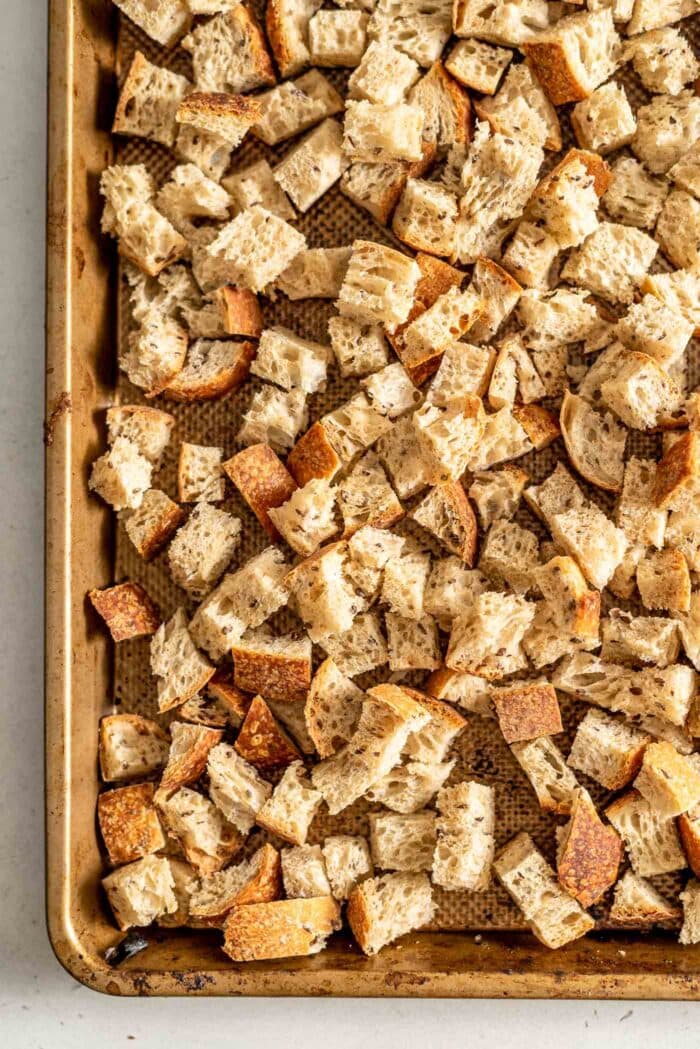
Step 1: Prepare the sourdough bread.
You have two options for preparing the bread for your stuffing. Cube the bread and then:
- Spread it out on a baking sheet and leave it out overnight, uncovered, to dry it out.
- Spread it a single layer a baking sheet and bake for about 10 minutes at 300 F until lightly crisp and a little golden. Be careful not to burn it!
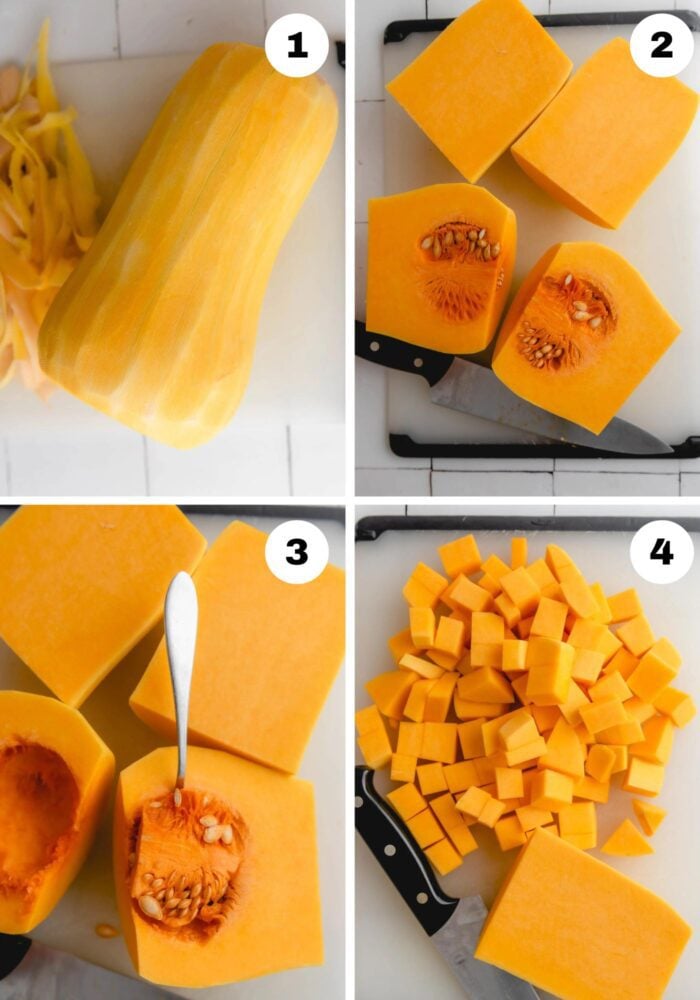
Step 2: Roast the butternut squash.
Preheat the oven to 400 F and start preparing the butternut squash. To prepare the squash:
- Cut the stems off the top and bottom so it’s flat on either end then peel the squash.
- Cut it in half crosswise so you have the top half and bottom half then cut each piece in half lengthwise.
- Scoop the pulp and seeds out of the bottom half.
- Cube the squash.
The recipe calls for 5 cups of cubed squash which is roughly a small to medium-sized squash. You can use a bit more or less if you like. The amount doesn’t have to be exact.
If you have extra squash, you can use it in a soup or salad like this roasted squash salad or slow cooker butternut squash soup.
Add the cubed squash to a baking sheet and toss with 2 tsp olive oil and a pinch of salt and pepper and roast it for 25-30 minutes until tender and browned.
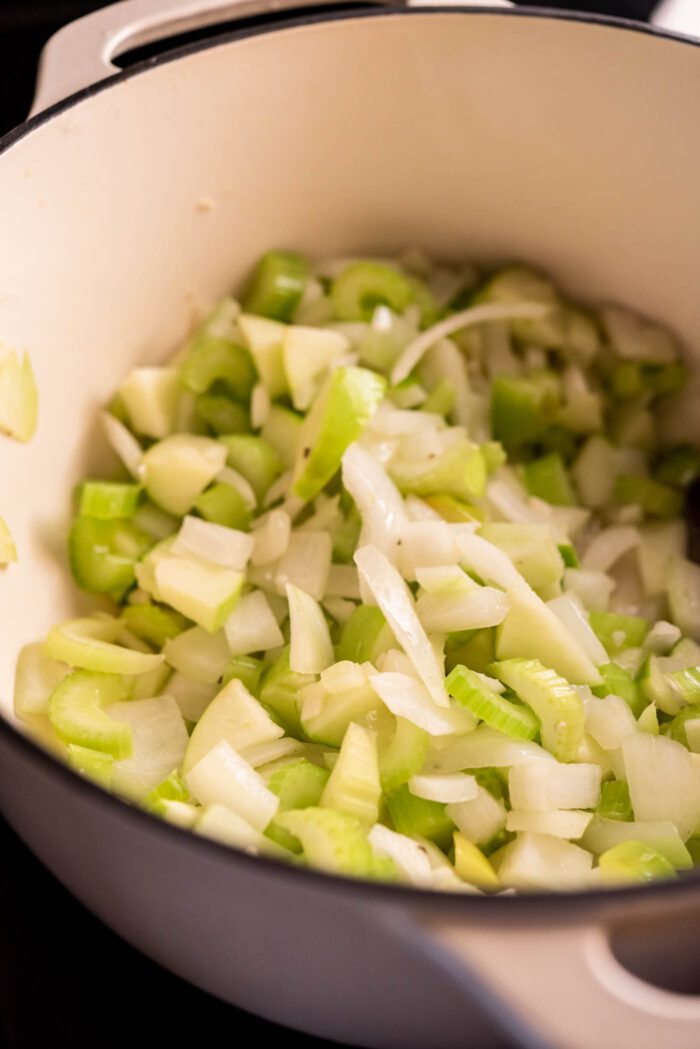
Step 3: Melt the butter in a large heavy bottom pot or skillet over medium heat. Once the butter is melted, add the onion, garlic, celery and apple and cook for 7-8 minutes until they’re softened.
Add the fresh sage and thyme and cook for another 1-2 minutes.
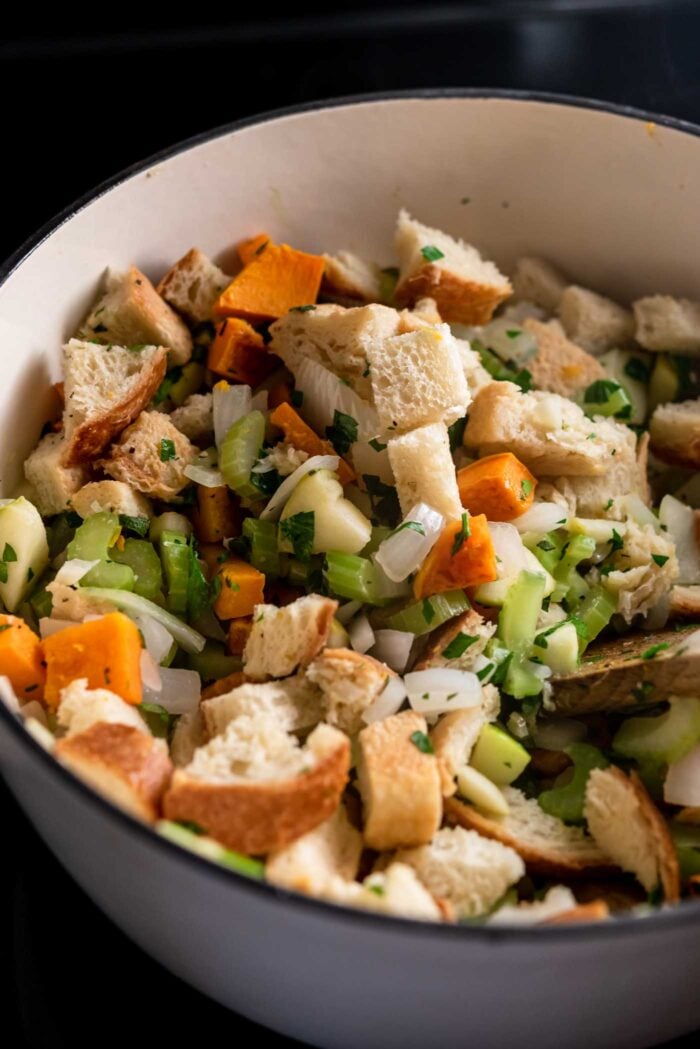
Step 4: Mix the stuffing either in the pot if it’s large enough or transfer everything to a large mixing bowl to combine.
Combine the roasted butternut squash, bread and vegetable mixture, along with 1.5 cups of the broth and mix well. Taste and season with salt and pepper
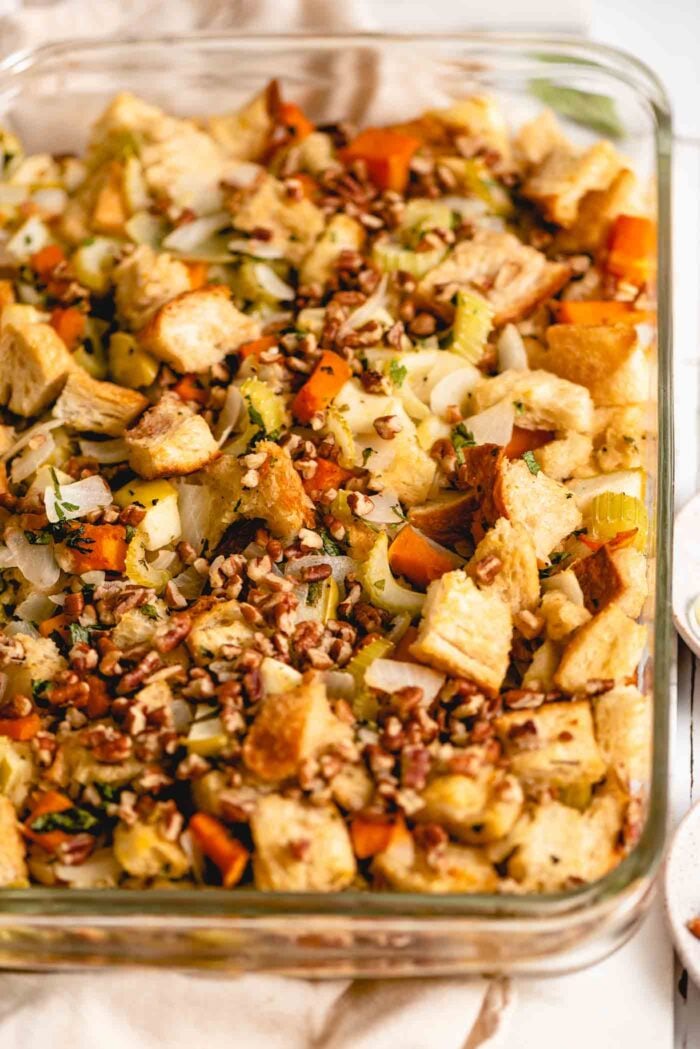
Step 5: Grease a 9×13-inch casserole dish then transfer the stuffing mixture. Drizzle with a bit more broth and sprinkle with the pecans, if you’re adding them.
Cover the dish with foil and bake for 25 minutes then remove the foil and bake for another 20-25 minutes until the golden brown and crispy on top.
Recipe FAQs
Yes. If you’d like to add sausage to this recipe, brown up to 1.5 cups ground plant-based meat such as Beyond or sliced Italian sausage in a skillet over medium heat before adding the onion.
Once cooked through and browned, add the onions, etc. and proceed with the recipe.
Yes. You can use any variety of squash such as acorn squash, pumpkin or delicata squash.
Yes, you can use frozen butternut squash cubes. Thaw them fully before roasting.
Yes. The stuffing will keep well in the freezer for up to 3 months. Let cool then wrap tightly to avoid freezer burn. Thaw the stuffing in the fridge or at room temperature and then reheat at 350 F, covered with aluminum foil until hot.
Store leftover squash stuffing in the fridge for up to 4 days. It can be stored wrapped in the casserole dish or transfered to an airtight container.
Reheat stuffing in the microwave in individual portions or in the oven at 350 F for about 10 minutes until heated through.
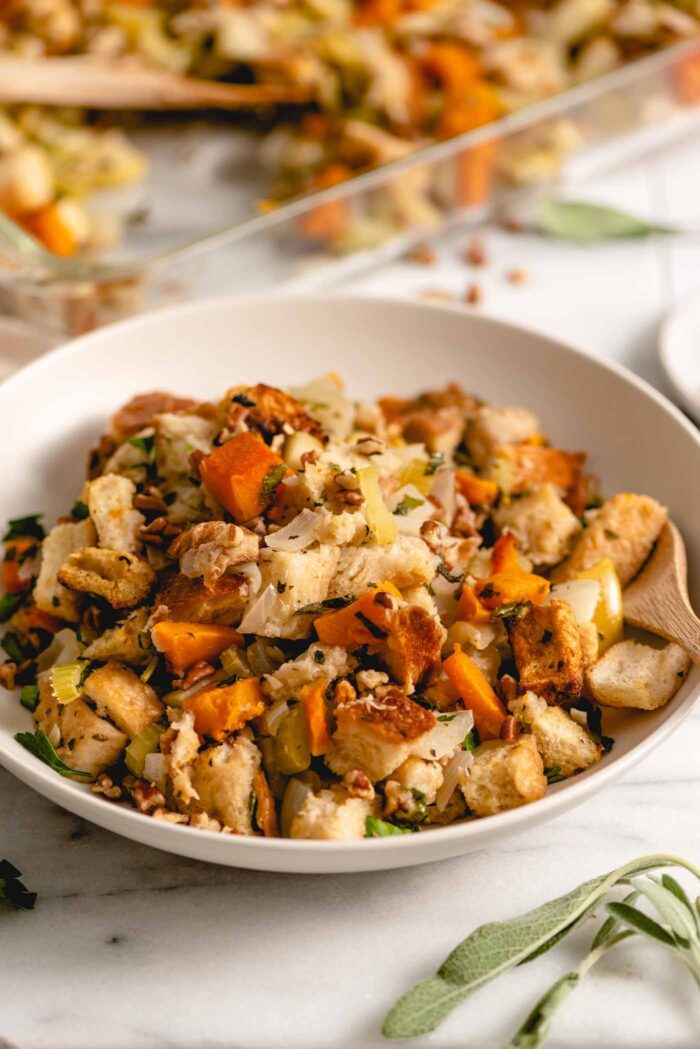
Expert Tips
- If you have a Dutch oven, you can use that to saute as it will be big enough to mix the stuffing in. If you do not have a large pot, you can use any pan to saute, then transfer everything to a mixing bowl to mix the stuffing.
- Note that some vegan butters and vegetable stocks are saltier than others, so taste and season as you proceed through the recipe.
- After you’ve mixed the stuffing, assess the amount of broth needed. The stuffing should be completely moistened but not soaking or soggy. If you add too much broth, you can add some additional bread to help soak it up.
- Do not skip drying the bread or your stuffing will be mushy due to soggy bread. Bread that’s been left out uncovered for a day is ideal, though if you haven’t prepared in advance, the oven method works well. You want the bread to be a bit hard and crunchy.
Tips for Making Ahead
- You can dry out the bread 1-2 days ahead. If the bread is ready but you’re not ready to cook yet, store the bread in a sealed bag or container until you’re ready.
- You can cook the onion mixture 1-2 days and advance and store it in the fridge.
- You can bake the stuffing ahead of time, cover with foil then reheat in the oven at 350 F for 10-15 minutes before serving.
- You can assemble the entire casserole, up until the point of baking, then cover and place in your fridge tightly covered for 1-2 days. Remove from fridge 45 mins before baking (to come to room temperature).
Butternut Squash Recipes
Did you try this recipe? I’d love to hear about it! Scroll down to the comment section to leave a star rating and review.
⭐️⭐️⭐️⭐️⭐️
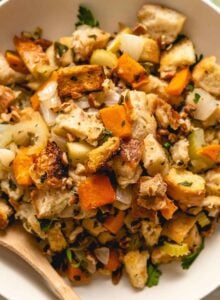
Vegetarian Butternut Squash Stuffing with Apple
- Prep Time: 10 mins
- Cook Time: 90 mins
- Total Time: 1 hour 40 minutes
- Yield: 8
- Category: Side Dish
- Cuisine: American
- Diet: Vegan
Description
Tender roasted butternut squash is the perfect addition to this twist on traditional Thanksgiving stuffing. Paired with sourdough bread, apple and fresh herbs, this delicious stuffing makes a wonderful addition to holiday meals.
Ingredients
- 5 cups cubed butternut squash (743 g)
- 2 tsp oil (10 mL)
- 8–9 cups cubed sourdough bread (375 g)
- ¼ cup vegan butter (60 g)
- 1 large white onion, chopped (2 cups, 250 g)
- 3–4 celery stalks, chopped (about 2 cups, 235 g)
- 1 small tart apple, like granny smith, diced (1 ¼ cups, 150 g)
- 3 cloves garlic, minced
- 2 tbsp fresh sage leaves, finely chopped
- 1 tbsp fresh thyme, stemmed and chopped (or 1 tsp dried thyme)
- ½ cup parsley, finely chopped
- 2–3 cups low-sodium vegetable broth (750 mL)
- ¼ cup pecans, optional (30 g)
- salt and pepper
Instructions
- Prep the bread: The day before you make the stuffing, place the bread cubes on a sheet pan and leave them out overnight, uncovered, to dry out. Alternately, you can place them on a sheet pan and bake at 300 F for about 10-15 minutes, until bread cubes are dry at the surface, but still soft in the center.
- Prepare: Preheat oven to 400 F and grease a 9×13-inch casserole dish.
- Roast Squash: Transfer the cubed squash to a rimmed baking sheet. Drizzle with 2 tsp oil and season with salt and pepper. Toss to combine. Roast the squash on the middle rack of the oven for 25-30 min, stirring halfway through, until tender and golden-brown.
- Saute Aromatics: Meanwhile, in a large, deep skillet, melt butter over medium heat. When the butter is melted, add onion, celery, apple and garlic. Season with salt and pepper. Some vegan butters and vegetable stocks are saltier than others, so make sure to season and taste as you go. Cook for 8-10 min, stirring occasionally, until onions are tender.
- Add Fresh Herbs: Add sage and thyme. Cook for 1-2 min, stirring often, until fragrant.
- Mix Stuffing: Add the dried bread, parsley, onion mixture and roasted squash to a large bowl or add everything to the cooking pot if it’s large enough. Add 1.5 cups of the vegetable broth. Mix well. Taste and season with salt and pepper if needed. Assess the amount of broth needed. The stuffing should be completely moistened but not soaking or soggy. I used 2 cups of broth in this step and another 1/2 cup over top before baking.
- Transfer to Baking Dish: Transfer the stuffing to the prepared baking dish, spreading out in an even layer. Drizzle with additional broth. Sprinkle with pecans if using. Cover the baking dish with foil.
- Bake Stuffing: Reduce the oven heat to 350 F. Bake covered for 25 min. Uncover and bake for another 25-30 min, until top becomes golden-brown and lightly crisped.
Notes
To make ahead you can dry out the bread 1-2 days ahead. Store the bread in a sealed bag or container until you’re ready. You can cook the onion mixture 1-2 days and advance and store it in the fridge. You can bake the stuffing ahead of time, cover with foil then reheat in the oven at 350 F for 10-15 minutes before serving. You can assemble the entire casserole, up until the point of baking, then cover and place in your fridge tightly covered for 1-2 days. Remove from fridge 45 mins before baking (to come to room temperature).
Leftover stuffing will keep in an airtight container or tightly wrapped in the casserole dish for up to 4 days in the fridge. Reheat in the oven for a crisp texture or in the microwave if you don’t mind it being softer.
Nutrition
- Serving Size: 1/8th of recipe
- Calories: 223
- Sugar: 8 g
- Sodium: 548 mg
- Fat: 5 g
- Carbohydrates: 40 g
- Fiber: 4 g
- Protein: 6 g

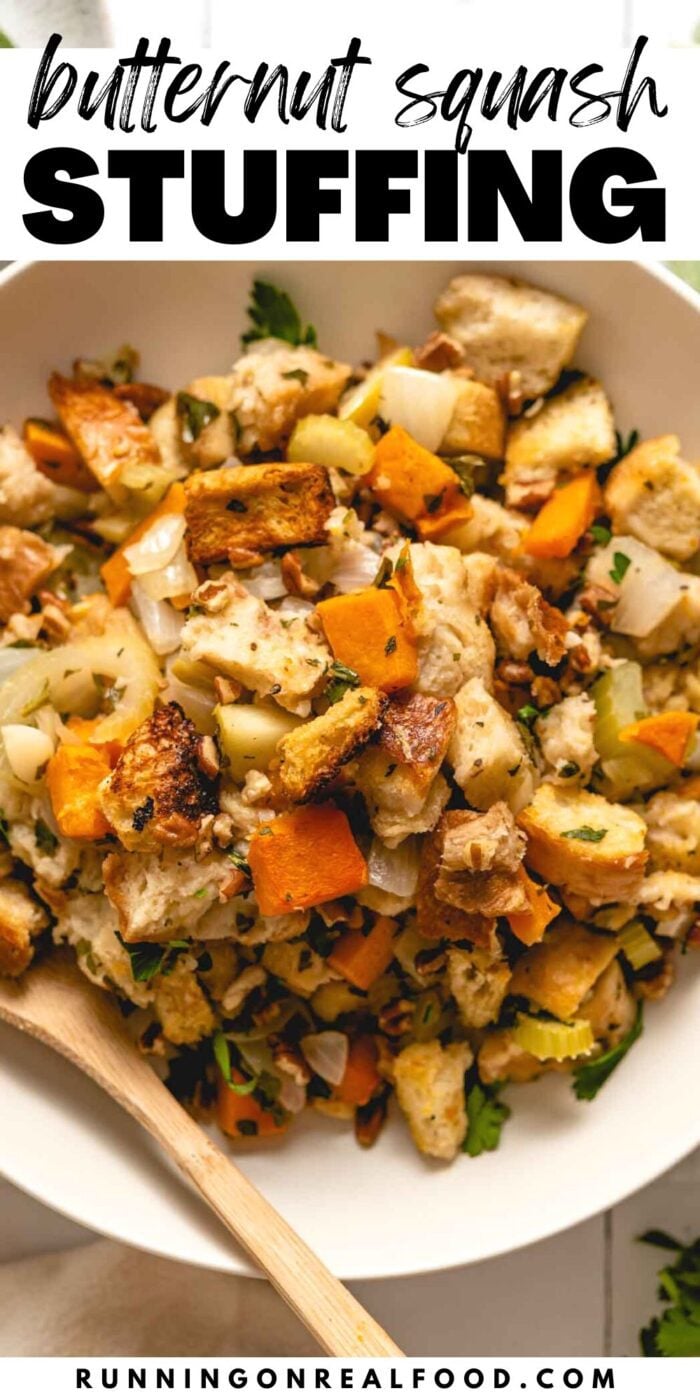
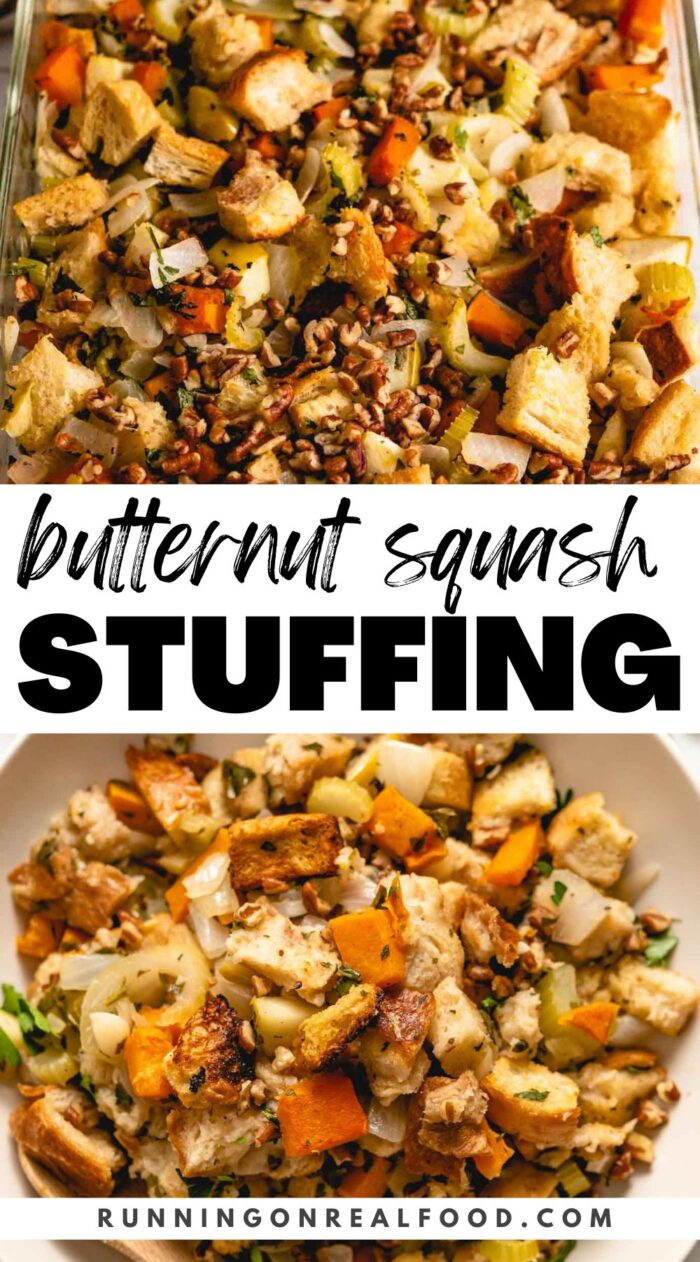


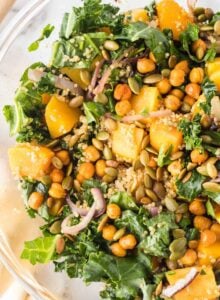
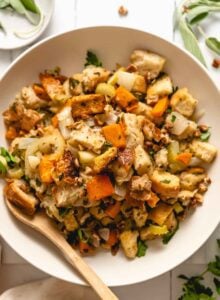

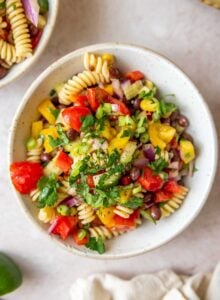
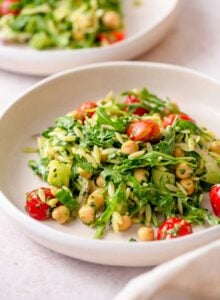
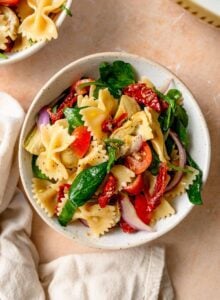
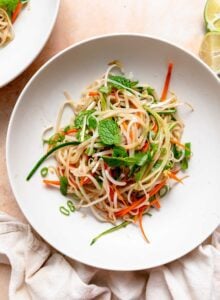
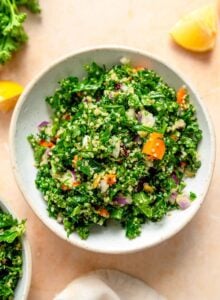
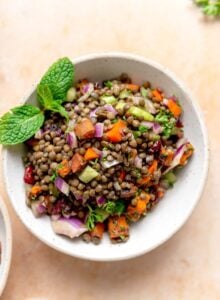
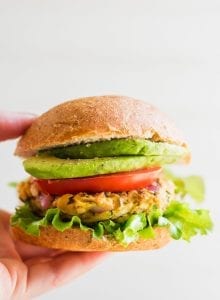
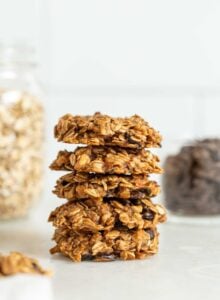
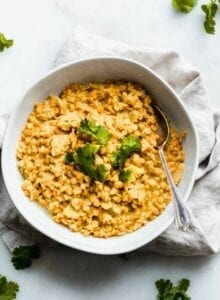
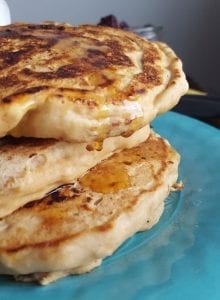
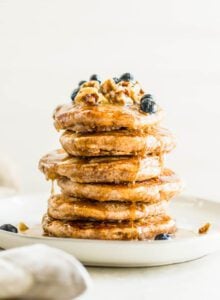

Tested this at Thanksgiving for a Christmas recipe – very good and I plan to use it again for Christmas dinner. I didn’t make any changes except only had dried thyme, which was fine, I’ll get fresh next time if I can.
Hello,
Can I add chestnuts instead of pecans?
thank you
Sure.